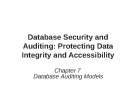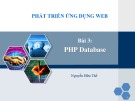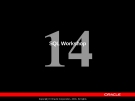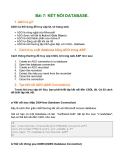
Creating a database
-
Bài giảng "Bảo mật cơ sở dữ liệu - Chapter 7: Database auditing models" trình bày các nội dung: Gain an overview of auditing fundamentals, understand the database auditing environment, create a flowchart of the auditing process, list the basic objectives of an audit. Mời các bạn cùng tham khảo.
 49p
49p  thangnamvoiva20
thangnamvoiva20
 20-09-2016
20-09-2016
 97
97
 9
9
 Download
Download
-
Bài giảng Phát triển ứng dụng Web: Bài 3 PHP Database cung cấp cho người học những kiến thức như: PHP MySQL Introduction; PHP MySQL Connect to a Database; PHP MySQL Create Database and Tables; PHP MySQL Insert Into; PHP MySQL Select; PHP MySQL The Where Clause; PHP MySQL Order By Keyword; PHP MySQL Update; PHP MySQL Delete; MySQL và Font Unicode; MySQLi.
 35p
35p  chuheodethuong
chuheodethuong
 11-07-2021
11-07-2021
 36
36
 4
4
 Download
Download
-
In this chapter you will: To understand how firms create an internal database, to learn about building a database from a Web site, to become familiar data mining, to understand the advantages and disadvantages of of using secondary data, to understand the role of the Internet in obtaining secondary data, to learn about types of information management systems.
 13p
13p  allbymyself_06
allbymyself_06
 28-01-2016
28-01-2016
 65
65
 4
4
 Download
Download
-
After completing this lesson, you should be able to do the following: Interpret the concept of a hierarchical query Create a tree-structured report Format hierarchical data Exclude branches from the tree structure
 18p
18p  trinh02
trinh02
 28-01-2013
28-01-2013
 48
48
 4
4
 Download
Download
-
This workshop covers: Creating tables and sequences Modifying data in the tables Modifying table definitions Creating views Writing scripts containing SQL and iSQL*Plus commands Generating a simple report
 14p
14p  trinh02
trinh02
 28-01-2013
28-01-2013
 74
74
 4
4
 Download
Download
-
Built-In Database Objects In addition to creating the database files, several other structures are created. Data dictionary: Contains descriptions of the objects in the database Dynamic performance tables: Contains information used by the database administrator (DBA) to monitor and tune the database and instance PL/SQL packages: Program units adding functionality to the database. These packages are created when the catproc.sql script is run after the CREATE DATABASE command. PL/SQL packages will not be discussed within the scope of this course.
 20p
20p  trinh02
trinh02
 28-01-2013
28-01-2013
 66
66
 4
4
 Download
Download
-
Before a database is created, the UNIX environment must be configured and the Oracle9i server must have already been installed. Four environment variables must be set: ORACLE_HOME, ORACLE_SID, PATH, LD_LIBRARY_PATH. ORACLE_HOME is the full path to the top directory in which the Oracle9i Server is installed. The directory for ORACLE_HOME should be supplied by the person who installed the server, usually the UNIX administrator or the DBA. ORACLE_SID is a user-definable name assigned to an instance of a database.
 10p
10p  trinh02
trinh02
 28-01-2013
28-01-2013
 63
63
 6
6
 Download
Download
-
Course Objectives This course is the first in a series of courses that cover the core database administrator tasks. The tasks covered in this course are: Outlining the Oracle architecture Planning and creating databases Managing the memory, process, physical, and logical structures Managing database users by controlling and monitoring their actions Using the Globalization Support features
 4p
4p  trinh02
trinh02
 28-01-2013
28-01-2013
 63
63
 4
4
 Download
Download
-
Once the SRS has been approved, implementation begins. Programming teams have many options: The programmers can simply start building the code and create the objects and user interface elements. Designers can build a user interface prototype to demonstrate to the users, stakeholders and the rest of the team. Any code used to develop the prototype is typically thrown away once the design has been finalized. Pictures, flow charts, data flow diagrams, database design diagrams and other visual tools can be used to determine aspects of the design and architecture.
 20p
20p  thanh_k8cntt
thanh_k8cntt
 13-09-2012
13-09-2012
 65
65
 6
6
 Download
Download
-
Bài 7: KẾT NỐI DATABASE. 1. ADO là gì? ADO Có thể dung để truy cập DL từ trang web. ADO là công nghệ của Microsoft ADO được viết tắt là ActiveX Data Objects ADO là một thành phần của Active-X ADO tự động cài đặt khi cài IIS ADO là môi trường lập trình giao tiếp với CSDL- database 1. Cách truy xuất database bằng ADO trong ASP. Cách thông thường để truy cập CSDL từ trang web ASP như sau: 1. 2. 3. 4. 5. 6. 7. Create an ADO connection to a database Open the database connection Create an ADO recordset...
 14p
14p  tengteng14
tengteng14
 20-12-2011
20-12-2011
 489
489
 21
21
 Download
Download
-
cách tạo một mệnh lệnh (command) và thực thi trên cơ sở dữ liệu (database). Tạo một mệnh lệnh (CREATING A COMMAND) Có rất nhiều cách ngoài cách sử dụng SqlCommand nhưng mình sẽ dùng cách này để làm ví dụ vì nó được cung cấp tốt nhất trong việc liên kết với cơ sở dữ liệu SQL. Mở Visual C# chọn Console Application và dùng thử code sau để phân tích :
 12p
12p  onlineit
onlineit
 07-06-2011
07-06-2011
 159
159
 31
31
 Download
Download
-
adduser Add a user to the system addgroup Add a group to the system alias Create an alias • apropos Search Help manual pages (man -k) apt-get Search for and install software packages (Debian/Ubuntu) aptitude Search for and install software packages (Debian/Ubuntu) aspell Spell Checker awk Find and Replace text, database sort/validate/index
 7p
7p  hellmaster
hellmaster
 26-04-2011
26-04-2011
 96
96
 13
13
 Download
Download
-
The Developer exam is challenging. There are a lot of complex design issues to consider, and a host of advanced Java technologies to understand and implement correctly. The exam assessors work under very strict guidelines. You can create the most brilliant application ever to grace a JVM, but if you don’t cross your t’s and dot your i’s the assessors have no choice but to deduct crucial (and sometimes substantial) points from your project.
 14p
14p  dmptit
dmptit
 04-11-2010
04-11-2010
 119
119
 11
11
 Download
Download
-
7,1 Tạo một Dialog Box để kết nối đến một cơ sở dữ liệu mới, bao gồm danh mục Available SQL Server và cơ sở dữ liệu người dùng đôi khi cần phải kết nối với cơ sở dữ liệu khác nhau.
 10p
10p  luvpro
luvpro
 06-08-2010
06-08-2010
 93
93
 6
6
 Download
Download
-
2,1 Create a New SQL Server cơ sở dữ liệu từ bên trong Visual Studio. NET Trước khi làm việc với cơ sở dữ liệu, bạn có để có thể tạo ra nó. Mặc dù bạn có thể sử dụng code để làm điều này, bạn thay vì sẽ làm điều đó ngay từ Visual Studio.
 3p
3p  luvpro
luvpro
 06-08-2010
06-08-2010
 132
132
 6
6
 Download
Download
-
7,5 Tạo một Tháo / Đính kèm SQL Server cơ sở dữ liệu Dialog Box trạng đôi khi phát sinh đòi hỏi một cơ sở dữ liệu được đính kèm, tách ra, hoặc cả hai.
 8p
8p  luvpro
luvpro
 06-08-2010
06-08-2010
 130
130
 12
12
 Download
Download
-
11,8 Tạo một cơ sở dữ liệu tài khoản người dùng đăng nhập mà bạn The tạo ra trong thế nào-Để 11,5 hoặc 11,6 cung cấp quyền truy cập vào SQL Server, nhưng không cho bất kỳ cơ sở dữ liệu trong SQL Server.
 3p
3p  luvpro
luvpro
 06-08-2010
06-08-2010
 111
111
 7
7
 Download
Download
-
[ Team LiB ] Recipe 2.12 Retrieving Stored Procedure Return Values Using a DataReader Problem You are using a stored procedure to create a DataReader and need to get the return value. When you try to access the value, it is null. How can you access the return value?
 4p
4p  luvpro
luvpro
 04-08-2010
04-08-2010
 92
92
 9
9
 Download
Download
-
[ Team LiB ] Recipe 7.16 Dynamically Creating Crystal Reports Problem You need to define a DataTable at runtime and bind it to a Crystal Report. Solution Create a DataAdapter and use it to fill a DataTable with a subset of records
 3p
3p  luvpro
luvpro
 04-08-2010
04-08-2010
 96
96
 13
13
 Download
Download
-
[ Team LiB ] Recipe 2.9 Returning an Output Parameter Using a DataReader Problem You want to access an output parameter returned by a stored procedure that you have used to create a DataReader. Solution Add a parameter
 4p
4p  luvpro
luvpro
 04-08-2010
04-08-2010
 97
97
 11
11
 Download
Download
CHỦ ĐỀ BẠN MUỐN TÌM
































